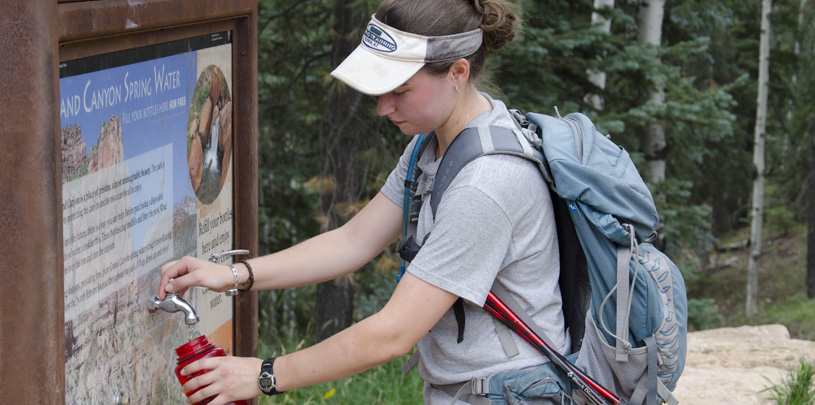
 by Ellen Heyn, Communications Associate
by Ellen Heyn, Communications AssociateA message from your parents asking you to call them back immediately—no more information, no less—triggers something like a panic attack: Who’s in the hospital? How bad was the accident? Was it a heart attack? Oh no, who died?
The summer after I graduated from college, I was out getting pizza when I got such a message. Assuming the worst, I called my parents back right away. My dad answered the phone.
“Dad, what’s going on? Is everything ok?”
“Everything’s fine,” he said, his tone serious, “except we just got a letter from the park service saying that you’re going to die on your Grand Canyon hike…”
I had gotten a similar message by email a week earlier in response to a backcountry permit request, but I’d brushed it off as a legal disclaimer, apparently also ignoring the last sentence:
"Note: In addition to this courtesy email, we will be sending you this same information by letter."
I had listed my parents’ address on my permit application (a mistake I realized the moment my dad answered the phone) because I was moving out of my apartment, packing my life into my car, and heading West on a post-grad adventure.
"Experience has shown that trips such as the one you requested all too often result in off-itinerary camping, injury, and occasionally even death. This is further compounded by the fact that you are seeking to do this hike alone– something that leaves an inadequate safety margin for dealing with problems that might come up…"
After reading the letter, my parents had every reason to worry. I was the youngest kid leaving their protective nest. Then, of course, there were the threats of dehydration, heat stroke, and rough terrain, not to mention my lack of backpacking experience. Point by point, I tried to ease my parents’ concerns.
But what the park service didn’t disclose in their list of potential dangers I’d encounter on my hike was perhaps the scariest of all—a radioactive creek whose uranium levels exceeds EPA safe drinking water standards.
In the Grand Canyon, where a vertical mile of rock separates you from the Colorado River, springs and creeks act as lifelines for backpackers. You strategically plan your campsites, mileages, and routes based entirely on where you can refill your water bottles.
On the Hermit–Tonto–Bright Angel backpacking loop, my planned itinerary and one of the most hiked backcountry trips in the canyon, water in two creeks—Horn Creek and Salt Creek—has been deemed unsafe for drinking. U.S. Geological Survey studies have shown those creeks to have radiation levels that exceed safety standards for human health.
The park service warns in its trail description for the route:
The radiation in Horn Creek came from the former Orphan Uranium Mine located upstream, on the Grand Canyon’s south rim. In 1987, when the park service acquired the previously private inholding where the abandoned Orphan Uranium Mine is located, they also adopted the land’s toxic legacy. In 13 years of mining uranium on the South Rim, the Orphan Mine allowed radiation to leach down the Horn Creek drainage, contaminating its water with dangerous amounts of uranium.
The same story could unfold again on the South Rim, this time six miles southeast of Grand Canyon Village, where the Canyon uranium mine is slated to resume operations after a 20-year hiatus.
Radiological contamination of Grand Canyon’s seeps and springs is on the line, and I think I speak for most hikers, as well as the 40 million people who depend on Colorado River Basin water, when I say that I don’t want to drink radioactive water.
My parents worry enough about me on Grand Canyon hiking trips—they don’t need to add radiation exposure at the nation’s crown-jewel national park to the list.
Orphan Mine, located two miles northwest of Grand Canyon Village, was originally claimed as a copper mine on private property in 1893. Predating the park, it changed hands several times while struggling to find its identity. Like an angsty teenager, Orphan Mine went from copper mine, to tourist complex, and finally settled on uranium mining in the early 1950s when the nuclear arms race gained momentum and demand for uranium soared.
But underground, the long narrow breccia pipes of uranium ore extended past the private property boundary into the park, and the mine owners felt entitled to the riches.
Industry won, and Congress granted them permission. When mining finished in 1969, the Orphan Mine had produced 800,000 tons of ore, 60 percent of which came from inside park boundaries.
Faced with the cost of cleaning up the mine site after closure, the company declared bankruptcy, leaving tax payers, the government, and the park service to foot the bill. Currently, the park service has spent $15 million of taxpayer money on just the first phase of a costly and lengthy clean-up.
80% of Arizona voters support Baaj Nwaavjo I'tah Kukveni National Monument, according to a new poll.
Read MoreThe Colorado River below Glen Canyon Dam is heating up. Find out why.
Read MoreGroundwater pumping at a uranium mine near the Grand Canyon will affect the canyon's springs, scientists says.
Read More